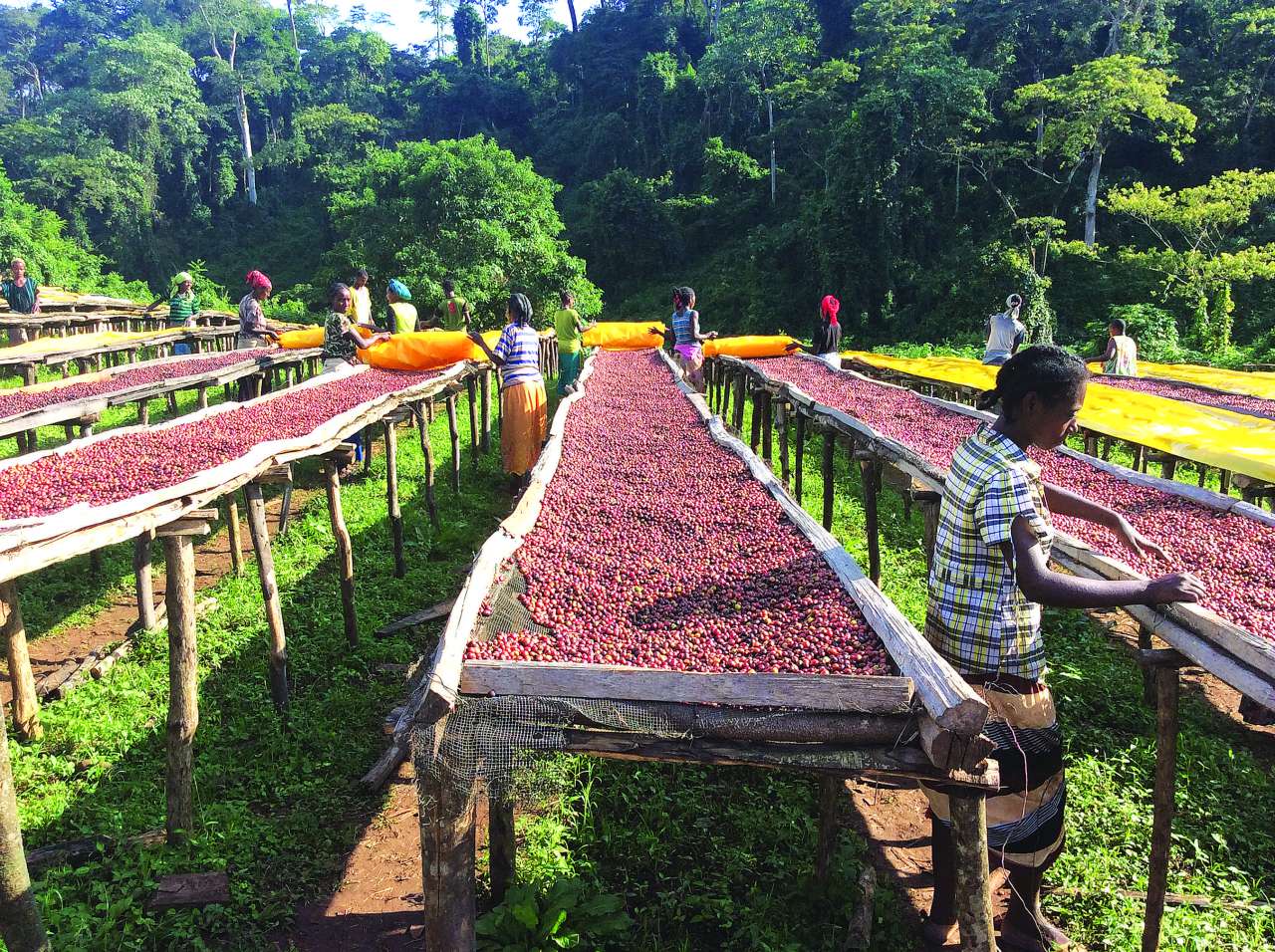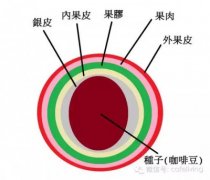Coffee treatment: what are the kinds of sun treatment? What's the difference between the sun and the half-sun?

Professional coffee knowledge exchange more coffee bean information please follow the coffee workshop (Wechat official account cafe_style)
The four most common processing methods of Brazilian coffee
A good way of handling can lead to the rich flavor of coffee. Just as wine needs to be well brewed to produce a wine with a great flavor.
The treatment method is also similar to the raw bean, different treatment methods will produce different characteristic flavor.
Solarization (Dry process/Natural method)
Dry process/Natural method is the oldest and most primitive treatment of coffee beans. Arabs used this method to deal with coffee more than a thousand years ago. The harvested coffee cherries are directly exposed to the sun on the terrace and receive direct sunlight exposure (about 27-30 days). The moisture content is changed from 60% to only 12%. The concept of this treatment is simple and inexpensive, but it has a lot of variables and risks; it has been used for a long time to deal with beans that are not of such good quality.
Flavor: soft acidity and uniform bitterness, thick, rich layers, obvious sweetness. Good quality sun beans will have a fruity or wine flavor.
Sun-drying: the fresh coffee fruit is put into the exposure field for sun-drying, and the water content is about 12% after 4 weeks of continuous turning and drying. Heat the coffee cherries evenly. After drying, the core and skin of the coffee will be separated, and then the pulp and peel will be removed by a sheller. And so on, the screening is completed.
Coffee beans from Moka in Yemen, Hara in Ethiopia, Brazil and Sulawesi in Indonesia are often treated in this way.
Washing method (Wet process/Washed method)
Water washing is a technology invented by the Dutch in the 18th century. It is suitable for rainy areas. Although the process is quite tedious, it is currently a more common method of raw bean treatment, accounting for about 70% of the total coffee. Use a peeling machine to separate most of the pulp from the coffee beans, then guide the shelled beans to a clean sink, soak them in water and ferment to completely remove the residual pulp layer. Through water treatment, unripe beans and defective beans are selected because of buoyancy, and the fermentation process is easier to control, so the flavor is not mixed like sun beans, but shows obvious acidity, complexity and cleaner (without any negative flavor, such as astringency or sharpness). But it is also because it is too "clean" and the richness of the flavor is a little weaker.
Flavor: acidity is strong, taste is cleaner, refreshing and bright.
Sift out floating beans: rinse the coffee fruit with clean water and remove the immature fruit that floats on the surface.
Remove the pulp: the fresh fruit is sent to the pulp sieving machine for peel and pulp removal.
Pectin removal: after removing the pulp, the seeds are moved into a fermentation tank and naturally fermented for about 16 Murray for 36 hours. After dissolving the surface pectin, the seeds are washed.
Drying and shelling: continue exposure to 1 Mel for 3 weeks to reduce the water content to 12%, and then remove the shell with a sheller.
Washed beans are bluish green in color and beautiful in appearance. Coffee from Guatemala, Colombia, Blue Mountains, Kona, Kenya, Java and Panama are all washed beans.
Semi-washing method (Semi washed method)
Semi-washing method, also known as wet stripping or wet planing. Different from other treatments, the coffee beans are not directly dried to a moisture content of 11 murmur12%, but when the moisture content is about 30-35%, the surface hard shell is removed and the surface of the raw beans is directly exposed, and then continue drying until the moisture content is non-perishable and easy to store, and this secondary drying gives the coffee beans a swampy dark green appearance. Coffee beans treated with semi-washing have lower acidity and thicker characteristics.
The flavor of semi-washed coffee is between sun-washing and water-washing. This method is popular in Indonesia. Mantenin uses more semi-washing methods, and Brazil has also begun to use semi-washing methods in recent years.
The semi-washing method is similar to the water washing method, first removing the outer skin and part of the pulp of the coffee cherry berries, then drying the berries, making the berries dry and then moistening them, and then using a special machine to grind off the pulp and remove the seeds.
Honey treatment (Honey Process/Miel Process)
The meaning of honey treatment comes from the sticky pectin layer of coffee beans before exposure, which feels as sticky as honey; when the coffee pulp is separated from the coffee beans, the outer coated pectin layer is exposed to absorb moisture in the air and make the pectin layer sticky. The "honey" here refers to the mucous layer of coffee pulp. After harvest, the fruit will peel off the outer skin with a peel machine, leaving the flesh to be exposed to the sun, so that the sweetness of the pulp can enter the beans, without having to take as long as the sun method.
The flavor shows: low acidity, high sweetness and fruity aroma, the cleanliness of the taste is higher than that of sun beans, and there is a tail of fermented wine after drying.
Peel off: after washing the coffee fruit with clean water, remove the peel and leave the pulp.
Sun drying: keep the flesh containing sugar to be exposed to the sun together. At this stage, it must be stirred to avoid mildew of raw beans.
Get raw beans: remove pulp, pectin and shell at once after drying.
Honey treatment is a popular treatment at present, and Central American countries such as Costa Rica and El Salvador are good at it.
.
Important Notice :
前街咖啡 FrontStreet Coffee has moved to new addredd:
FrontStreet Coffee Address: 315,Donghua East Road,GuangZhou
Tel:020 38364473
- Prev

What are the treatment methods for coffee beans? the five most common ways to treat raw coffee beans
Professional coffee knowledge exchange more coffee bean information please pay attention to the coffee workshop (Wechat official account cafe_style) the four most common treatment methods of Brazilian coffee to say, the treatment of raw coffee beans, first of all, we have to talk about how coffee comes from? Coffee trees from seedlings to blossom, and finally bear fruit, is the origin of coffee. Coffee fruit, also known as coffee cherry, coffee beans are
- Next

What are the methods of pulp treatment? Does pulp treatment include pulp treatment?
Professional coffee knowledge exchange more coffee bean information please pay attention to the coffee workshop (Wechat official account cafe_style) the four most common treatment methods of Brazilian coffee the basic skills of good quality coffee since the black tide [* Note], coffee beans sold in the market have also hit the slogan of fine products one by one, advocating a single producing area, micro-climate, various treatments and so on.
Related
- What is the meaning of lactic acid fermentation with coffee bean treatment?
- How to judge the state of foam by sound?
- How does the latte pull out the unicorn pattern? Come to get for a little trick to improve the flower pull!
- Will flower pulling affect the taste of the latte?
- Do you know the history of coffee?
- The difference between honey treatment and sun washing what is raisin honey treatment?
- What kind of milk can a novice use to make coffee foam to keep the foam longer? The correct method and skills of milking tutorial sharing
- Why do washed coffee beans taste sour? Flavor characteristics of washed Coffee
- Introduction to the skill of how to practice the size and height of water injection around the circle of hand-brewed coffee
- How do beginners practice coffee flower drawing from scratch?

